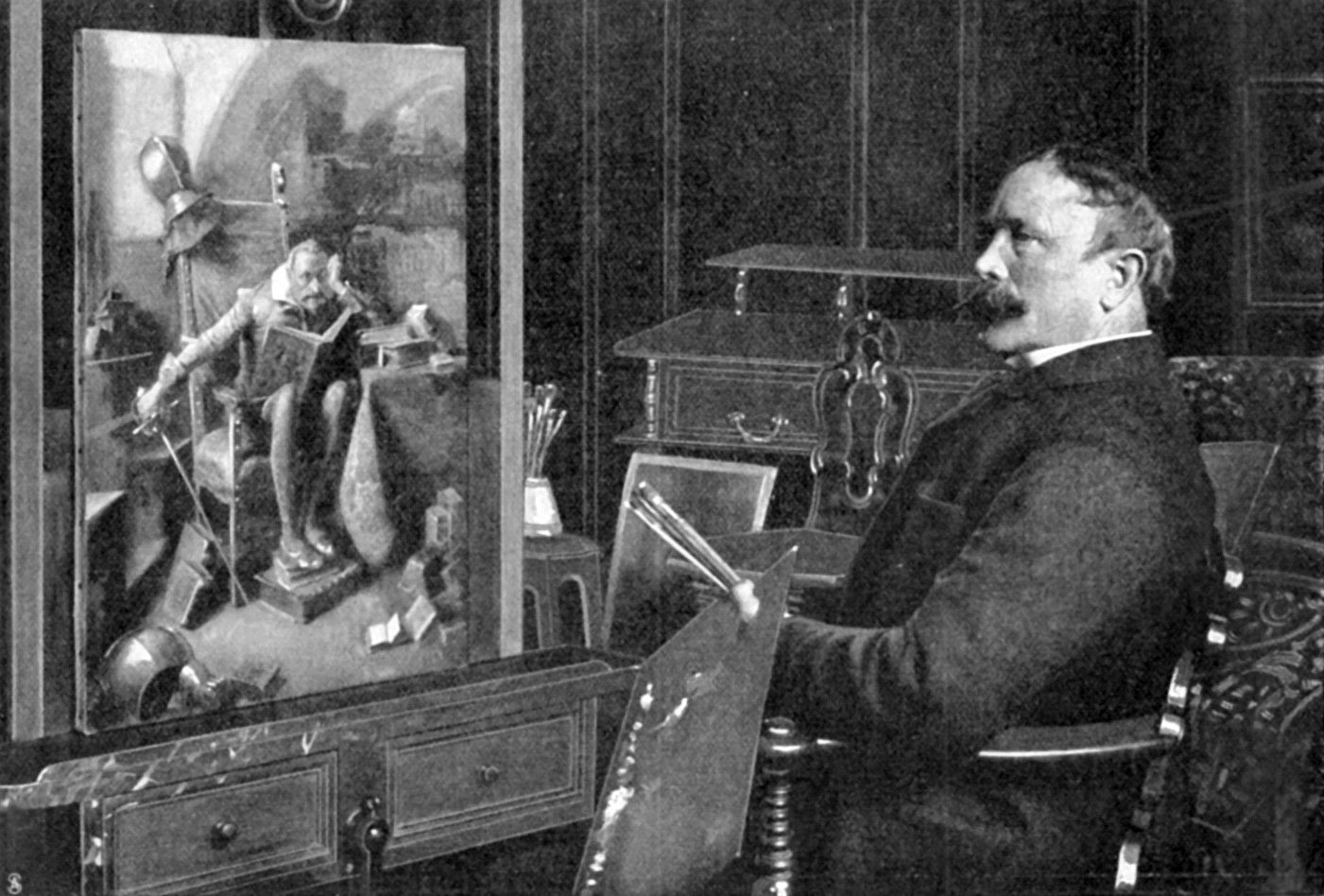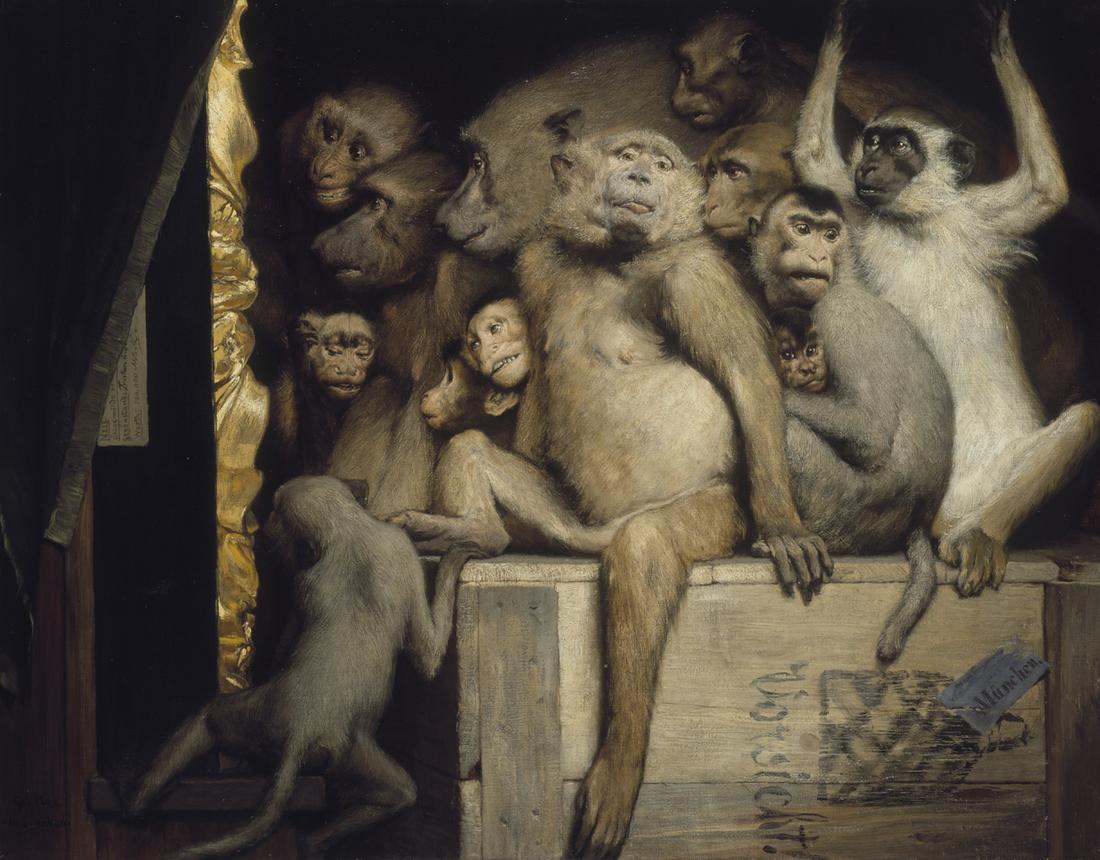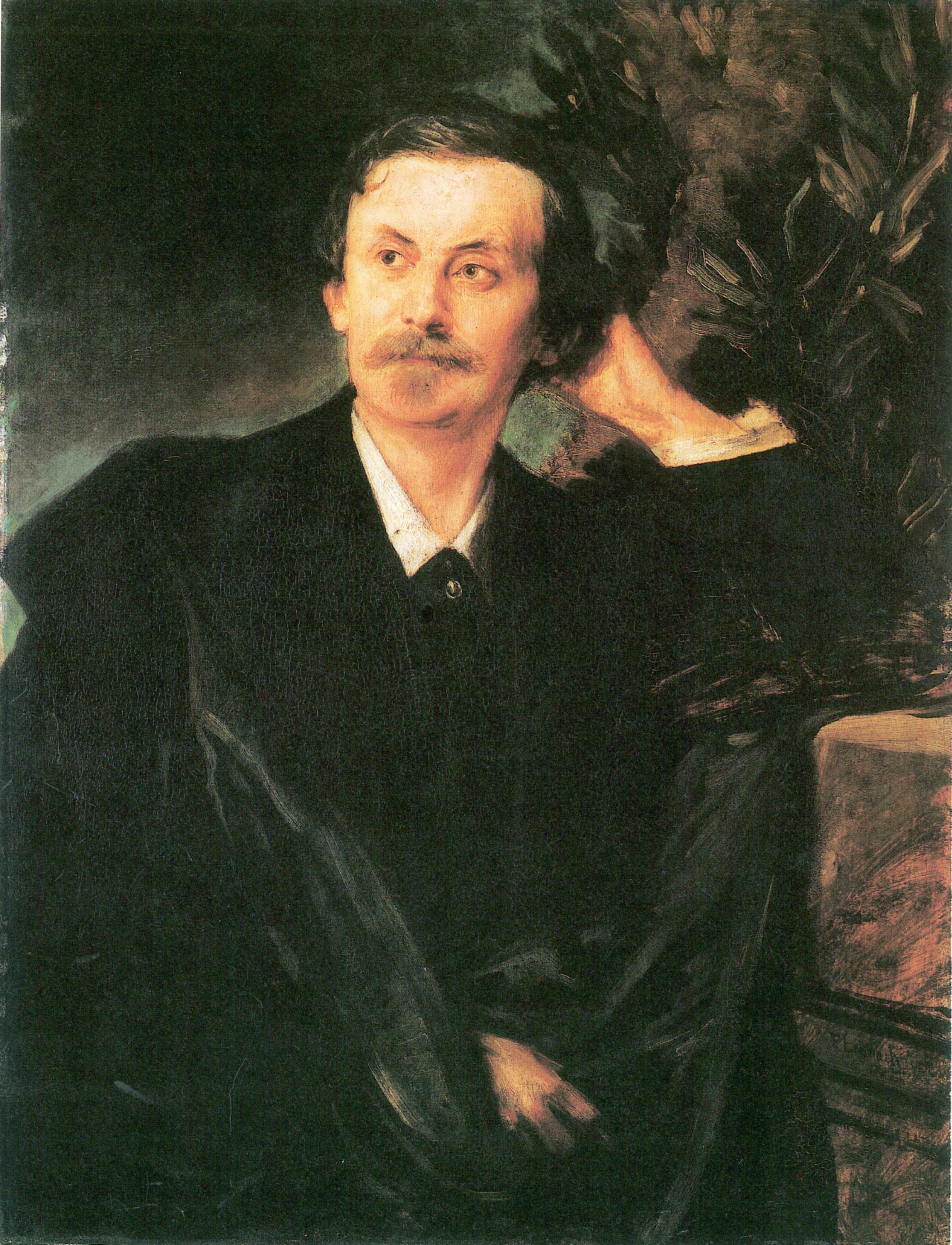|
Carl Von Piloty
Karl Theodor von Piloty (1 October 1826 – 21 July 1886) was a German painter, noted for his historical subjects, and recognised as the foremost representative of the realistic school in Germany. Life and work Piloty was born in Munich. His father, Ferdinand Piloty (d. 1844), enjoyed a great reputation as a lithographer. In 1840, Karl was admitted as a student of the Munich Academy, under the artists Karl Schorn and Julius Schnorr von Karolsfeld. A year later the acclaimed history paintings (referred to as the 'Belgian paintings'), i.e. the '' Compromise of the nobles'' and ''The Abdication of Charles V'' by the two Belgian artists Edouard de Bièfve and Louis Gallait, were shown in Munich and their realistic depiction of a historic subject matter made a lasting impression on him. After a journey to Belgium, France and England, Piloty commenced work as a painter of genre pictures, and in 1853 produced a work, ''Die Amme'' (''The Wet Nurse''), which, on account of its origin ... [...More Info...] [...Related Items...] OR: [Wikipedia] [Google] [Baidu] |
Piloty 01
Piloty is a surname: * Karl von Piloty (1826–1886), German painter * Ferdinand Piloty (der Ältere; 1786–1844), German lithographer * Ferdinand von Piloty (der Jüngere; 1828–1895), German painter and illustrator * Oskar Piloty Oskar Piloty (30 April 1866 – 6 October 1915) was a German chemist. Life Oskar Piloty was born the son of the painter Karl von Piloty in Munich. Due to the closeness of the Piloty family to the chemist Ludwig Knorr, who later married the ... (1866–1915), German chemist * Robert Piloty (1924–2013), Computer scientist {{surname ... [...More Info...] [...Related Items...] OR: [Wikipedia] [Google] [Baidu] |
Catholic League (German)
The Catholic League ( la, Liga Catholica, german: Katholische Liga) was a coalition of Catholic states of the Holy Roman Empire formed 10 July 1609. While initially formed as a confederation to act politically to negotiate issues vis-à-vis the Protestant Union (formed 1608), modelled on the more intransigent ultra-Catholic French Catholic League (1576), it was subsequently concluded as a military alliance "for the defence of the Catholic religion and peace within the Empire". Notwithstanding the league's founding, as had the founding of the Protestant Union, it further exacerbated long standing tensions between the Protestant reformers and the adherents of the Catholic Church which thereafter began to get worse with ever more frequent episodes of civil disobedience, repression, and retaliation that would eventually ignite into the first phase of the Thirty Years' War roughly a decade later with the act of rebellion and calculated insult known as the Second Defenestration o ... [...More Info...] [...Related Items...] OR: [Wikipedia] [Google] [Baidu] |
Thusnelda
Thusnelda (; 10 BC – after AD 17) was a Germanic Cheruscan noblewoman who was captured by the Roman general Germanicus during his invasion of Germania. She was the wife of Arminius. Tacitus and Strabo cite her capture as evidence of both the firmness and restraint of Roman arms. Biography Thusnelda was the daughter of the pro-Roman Cheruscan prince Segestes. In 9 AD, Arminius, Thusnelda's future husband, who had been given by his father to the Romans as a child and raised as a Roman military commander serving under Publius Quinctilius Varus, switched sides to the Germans, and led a coalition of Germanic tribes that defeated the legions of Varus at the Battle of the Teutoburg Forest. The conflict between the Roman Empire and the Germanic tribes continued after the Battle of the Teutoburg Forest, and Arminius abducted and impregnated Thusnelda circa 14 AD, likely as a result of a dispute with her pro-Roman father. In May 15 AD, Thusnelda was captured by Germanicus, who comm ... [...More Info...] [...Related Items...] OR: [Wikipedia] [Google] [Baidu] |
Wallenstein
Albrecht Wenzel Eusebius von Wallenstein () (24 September 1583 – 25 February 1634), also von Waldstein ( cs, Albrecht Václav Eusebius z Valdštejna), was a Bohemian military leader and statesman who fought on the Catholic side during the Thirty Years' War (1618–1648). His successful martial career made him one of the richest and most influential men in the Holy Roman Empire by the time of his death. Wallenstein became the supreme commander of the armies of the Imperial Army of Holy Roman Emperor Ferdinand II and was a major figure of the Thirty Years' War. Wallenstein was born in the Kingdom of Bohemia into a poor Protestant noble family. He acquired a multilingual university education across Europe and converted to Catholicism in 1606. A marriage in 1609 to the wealthy widow of a Bohemian landowner gave him access to considerable estates and wealth after her death at an early age in 1614. Three years later, Wallenstein embarked on a career as a mercenary by raising ... [...More Info...] [...Related Items...] OR: [Wikipedia] [Google] [Baidu] |
Anne Boleyn
Anne Boleyn (; 1501 or 1507 – 19 May 1536) was Queen of England from 1533 to 1536, as the second wife of King Henry VIII. The circumstances of her marriage and of her execution by beheading for treason and other charges made her a key figure in the political and religious upheaval that marked the start of the English Reformation. Anne was the daughter of Thomas Boleyn, 1st Earl of Wiltshire, and his wife, Lady Elizabeth Howard, and was educated in the Netherlands and France, largely as a maid of honour to Queen Claude of France. Anne returned to England in early 1522, to marry her Irish cousin James Butler, 9th Earl of Ormond; the marriage plans were broken off, and instead, she secured a post at court as maid of honour to Henry VIII's wife, Catherine of Aragon. Early in 1523, Anne was secretly betrothed to Henry Percy, son of Henry Percy, 5th Earl of Northumberland, but the betrothal was broken off when the Earl refused to support their engagement. Cardinal Thom ... [...More Info...] [...Related Items...] OR: [Wikipedia] [Google] [Baidu] |
Henry VIII
Henry VIII (28 June 149128 January 1547) was King of England from 22 April 1509 until his death in 1547. Henry is best known for his six marriages, and for his efforts to have his first marriage (to Catherine of Aragon) annulled. His disagreement with Pope Clement VII about such an annulment led Henry to initiate the English Reformation, separating the Church of England from papal authority. He appointed himself Supreme Head of the Church of England and dissolved convents and monasteries, for which he was excommunicated by the pope. Henry is also known as "the father of the Royal Navy" as he invested heavily in the navy and increased its size from a few to more than 50 ships, and established the Navy Board. Domestically, Henry is known for his radical changes to the English Constitution, ushering in the theory of the divine right of kings in opposition to papal supremacy. He also greatly expanded royal power during his reign. He frequently used charges of treason a ... [...More Info...] [...Related Items...] OR: [Wikipedia] [Google] [Baidu] |
Eduard Von Grützner
Eduard Theodor Ritter von Grützner (May 26, 1846 – April 2, 1925) was a German painter and professor of art. He was especially noted for his genre paintings of monks. He also repeatedly portrayed Falstaff. Childhood Grützner was born in 1846 into a noble family in Groß-Karlowitz near Neisse, Upper Silesia, Prussia (now Poland). His father was a prominent member of the church, and the local pastor often visited his parents' home. He recognized Eduard's talent and inclination for painting early on. The administrator of a ducal country house in the neighborhood got him paper, and eventually the pastor gained him entrance to the ''Gymnasium'' (a university preparatory school) of Neisse. Studies In 1864, the pastor brought Grützner to the private school of Hermann Dyck in Munich for art education, though his tenure at the Kunstgewerbeschule under Dyck was of short duration. In the first semester he transferred to the Classical Art class of Johann Georg Hiltensperge ... [...More Info...] [...Related Items...] OR: [Wikipedia] [Google] [Baidu] |
Georgios Jakobides
Georgios Jakobides (Γεώργιος Ιακωβίδης; 11 January 1853 – 13 December 1932) was a painter and one of the main representatives of the Greek artistic movement of the Munich School. He founded and was the first curator of the National Gallery of Greece in Athens. Life He was born in Chidira, Lesbos, Ottoman Empire. At the age of 13, he traveled to Smyrna to live with his uncle and study at the Evangelical School. From 1870 to 1876, Jakobides studied sculpture and painting at the Athens School of Fine Arts, and in 1877 he went to the Academy of Fine Arts in Munich on a scholarship to continue his painting studies under Karl Theodor von Piloty. In Munich, he lived for 17 years where he worked in his studio, painting mythological scenes, genre pictures, and portraits. His work is influenced by German academic Realism. His most famous paintings were of children but it said that after his wife's death in 1889, he stopped painting happy themes. In the capital of Bavar ... [...More Info...] [...Related Items...] OR: [Wikipedia] [Google] [Baidu] |
Gabriel Von Max
Gabriel Cornelius Ritter von Max (23 August 1840 – 24 November 1915) was a Prague-born Austrian painter. Biography He was born Gabriel Cornelius Max, the son of the sculptor Josef Max and Anna Schumann. He studied between 1855 and 1858 at the Prague Academy of Arts with Eduard von Engerth. His studies included parapsychology (somnambulism, hypnotism, spiritism), Darwinism, Asiatic philosophy, the ideas of Schopenhauer, and various mystical traditions. The spiritual-mystical movement was emphasized by the writings of Carl du Prel, and the Munich painter Albert Keller was also an influence. His first large canvas was painted in 1858 while he was a student at the Prague Academy. He continued his studies at the Viennese Academy of Art with Karl von Blaas, , Christian Ruben and Carl Wurzinger. From 1863 to 1867 he studied at the Munich Academy with Karl Theodor von Piloty, and also Hans Makart and Franz Defregger. His first critical success was in 1867 with the painting " ... [...More Info...] [...Related Items...] OR: [Wikipedia] [Google] [Baidu] |
Franz Defregger
Franz Defregger (after 1883 Franz von Defregger) (30 April 1835 – 2 January 1921) was an Austrian artist known for producing genre art and history paintings set in his native county of Tyrol. Biography Franz Defregger was born on 30 April 1835 at the Ederhof in Stronach, Tyrol in the Austrian Empire. He was the second son of Maria (née Fercher) and Michael Defregger, a farmer, who also had five daughters. His mother and two of his sisters died in 1841 during a typhoid epidemic. Franz himself nearly died from the fever. During his early years, Franz developed a strong love of music, and learned to play the flugelhorn. He soon became a member of a local band in Dölsach, playing at weddings, assemblies, and balls. Franz also displayed an early talent for drawing and woodcarving, which he developed autodidactically while working on his father's farm. After his father died in 1858, Franz took over the farm at the age of twenty-three. Within two years, however, he sold the ... [...More Info...] [...Related Items...] OR: [Wikipedia] [Google] [Baidu] |
Franz Von Lenbach
Franz Seraph Lenbach, after 1882, Ritter von Lenbach (13 December 1836 – 6 May 1904), was a German painter known primarily for his portraits of prominent personalities from the nobility, the arts, and industry. Because of his standing in society, he was often referred to as the "Malerfürst" (Painter Prince). Biography His father, who originally came from South Tyrol where the family name was spelled "Lempach", was a Master Mason for Schrobenhausen, where Lenbach was born. Lenbach completed his primary education at Landsberg in 1848, then attended a business school in Landshut. From 1851 to 1852, he was apprenticed to the sculptor Anselm Sickinger in Munich. At that time, his father died and he went home to help in the family business. He was only there a short time before beginning studies at the Augsburg University of Applied Sciences. While there, he drew and painted in his spare time, befriended Johann Baptist Hofner (1832–1913), the animal painter, and decided to bec ... [...More Info...] [...Related Items...] OR: [Wikipedia] [Google] [Baidu] |
Hans Makart
Hans Makart (28 May 1840 – 3 October 1884) was a 19th-century Austrian academic history painter, designer, and decorator. Makart was a prolific painter whose ideas significantly influenced the development of visual art in Austria-Hungary, Germany, and beyond. Life Makart was the son of a chamberlain at the Mirabell Palace, born in the former residence of the prince-archbishops of Salzburg, the city in which Mozart had been born. Initially, he received his training in painting at the Vienna Academy between 1850 and 1851 from Johann Fischbach. While in the Academy, German art was under the rule of a classicism, which was entirely intellectual and academic—clear and precise drawing, sculpturesque modelling, and pictorial erudition were esteemed above all. Makart, who was a poor draughtsman, but who had a passionate and sensual love of color, was impatient to escape the routine of art school drawing. For his fortune, he was found by his instructors to be devoid of all talent ... [...More Info...] [...Related Items...] OR: [Wikipedia] [Google] [Baidu] |




.png)





